Design and Comparison of Terahertz Graphene Antenna: Ordinary dipole, Fractal dipole, Spiral, Bow-tie and Log-periodic
Biabanifard M1, Biabanifard S*2, Javad Hosseini S3 and Jahanshiri A3
1Department of Electrical Engineering, KN Toosi University of Technology, Iran
2Department of Engineering, Iran Analog Research Group, Iran
3Department of Engineering, Buin Zahra Technical University, Iran
Submission: June 07, 2018; Published: July 25, 2018
*Corresponding author: Sadegh Biabanifard, Department of Electrical Engineering, Iran Analog Research Group, Tehran, Iran, Email: biabani.sadegh@gmail.com
How to cite this article: Biabanifard M, Biabanifard S, Javad Hosseini S, Jahanshiri A. Design and Comparison of Terahertz Graphene Antenna: Ordinary dipole, Fractal dipole, Spiral, Bow-tie and Log-periodic. Eng Technol Open Acc. 2018; 2(2): 555584. 10.19080/ETOAJ.2018.02.555584
Abstract
This paper investigated several configurations of terahertz graphene antenna. Five structures: Ordinary dipole, Fractal dipole, Spiral, Bow-tie and Log-periodic antenna have been investigated and graphene is the main substance while a thin layer of SiO2 as a bed was used. The fractal dipole and round spiral antenna in the terahertz band and comparison of these structures for the first time has been considered. Designed antenna are credited, exploiting proper full-wave numerical simulations while using time domain simulations. According to simulation results, designed round spiral and log-periodic antennas show adaptive behavior on wide range of frequencies and confirms wideband operation. Also, antenna is compared regarding on board sizes and the absorption cross section. The radiation efficiency is above 85% for all antennas. The results of this study can offer design insight and give vision to researchers, selecting appropriate structure with specific features and applications (Figure 1).
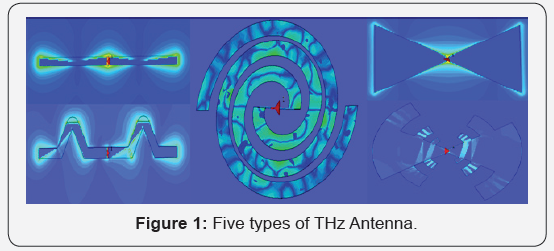
Keywords: Terahertz antenna; Graphene; Log-periodic; Dipole; Bow-tie; Fractal
Introduction
In recent years, Nano technology has provided novel solutions for engineering society. So, fabrication of electronic devices for specific application are realized and appropriately discussed. In any effort to increase sustainability and energy efficiency, neither productivity nor quality should suffer – quite the opposite should be the case. Increased sustainability and efficiency can only be achieved through the use of reliable and modern technology. Graphene based devices outperform silicon products, regarding higher operational frequency, design efficiency and even fewer losses. So, researchers hope, graphene will pavethe way to new era of high frequency-high efficiency electronics and optical devices. As a two-dimensional substance, Graphene shows transparent structure with hexagonal shape, has attracted a lot of attention due to its excellent physical, electrical and optical properties [1]. Starting with transparency, Graphene has constantly extended its range of properties in recent years. Nowadays this 2-D substance meets a growing range of requirements, from excellence electrical properties and simple control of charge careers to reliable frequency response. Extensive research and investigations have begun and continue to design, description and implementation of graphene-based Nano devices. Long and highlighted list of these researches is existing. For instance, ultra-high-speed transistor [2], transparent solar cells [3], meta-materials [4] and graphene plasmonics [5-6] are among most known fields. Regarding increasing demand for high speed operation and powerful processing, the need of design and fabrication of high frequency antennas is rising. On the other hand, one of the functional features of graphene is the ability to operate in high frequencies, which can be used in wireless communications and terahertz band [7]. Due to comparable depth of penetration with wavelength and increasing losses, we cannot increase operation frequency via dimension reduction. Since in a few micro-meter structure, the microwave rules are not entirely true in this area, so concept like PEC which exploits in microwave analysis is not compatible in the new shrinked domain, but still a half-wavelength antenna with 1 micro-meter long works at frequency about 150THz. This phenomena is justifiable, exploiting effective wavelength concept, which states antenna design can be transferred to optical frequencies with linear effective wavelength substituting [8]. The planar antenna which are placed on the substrate are mainly different from microwave antenna, because they tend to radiate in the sub bed medium and power division of each medium varies approximately as [9]. Basic research of planar structure of graphene antenna are studied in [10,11]. Graphene-based Nano patch and different shape of such antenna have been studied in [12,13] and [14] respectively. These antennas radiate, harvesting the graphene capability of supporting Surface Plasmon Polaritons (SPPs) which is comprehensively presented in [15,16]. In addition, propagation of SPP waves on doped graphene is analyzed, studied and proved [17-19].
In this work, to exploit the fascinating potential of this transparent material, five famous types of antenna are designed and simulated which graphene is main substance in these structures. We consider an ordinary dipole antenna with L as length and was width, with two separate graphene arms, as basic design for other antennas. All of presented configurations lay on a thin layer of SiO2 as substrate. Return Loss, Bandwidth, Absorption Cross Section, Directivity and Radiation Efficiency are numerically simulated and analyzed. The remainder of this paper is organized as follows. In section 2, the expression used to model the electric conductivity of graphene is presented. In section 3, the ordinary dipole antenna has been analyzed and design of other configurations is obtained based on the approximate length and exact width of ordinary dipole antenna. In next sub-section, the fractal dipole antenna has been designed and analyzed. The other sub-sections are design and analysis of spiral, bow-tie and log-periodic structures. In the section 4, the comparison of these structures has been presented and finally the paper has been concluded.
Modeling of Graphene Conductivity
The conductivity of graphene, an allotrope of carbon in the form of a two-dimensional material, includes two parts, interband and intraband transitions. Since we are working on lower terahertz frequencies, intraband transition is considered solely [20] which is modeled using Kubo formula [16]. So, we assume that in low frequencies in terahertz band, intraband is just represented graphene conductivity. By harvesting random phase approximate method, surface conductivity of graphene with the time harmonic dependency of exp (jωt) can be descript in local form [13]:

Where e is the electron charge, kB is the Boltzman constant, ℏ is the reduced Planck’s constant, τ is the transport relaxation time, T is the temperature and μc is the chemical potential. In this work, we use T=300K (ambient temperature) and τ =1ps. These values are considered to as real as possible graphene parameters. The real and imaginary parts of intraband conductivity are depicted in Figure 2.
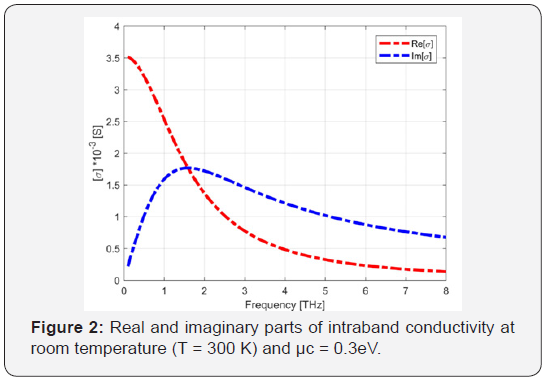
The chemical potential of graphene can be controlled using gate voltage. In all sections, μc is considered equal to 0.3eV. To developing a reliable library to simulate graphene, a combination of Drude model and surface conductivity can be used to determine the plasma frequency as follows:

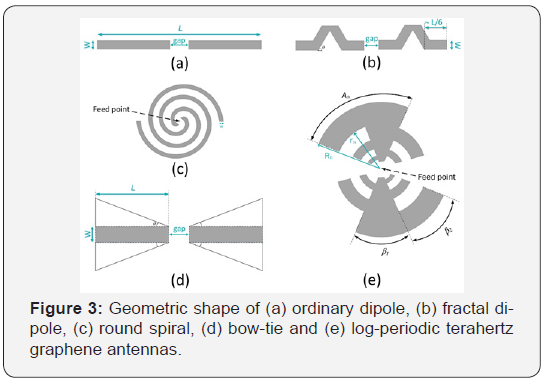
A detailed description is represented in Appendix A.
Simulation and Analysis
Five configurations that mentioned above is depicted in Figure 3. In this section, these structures will be analyzed and simulated at low frequency of terahertz band. Graphene with a thickness of 0.34nm is used in these structures and the results, exploiting time domain simulations has been achieved using CST Studio ver. 2016.
Ordinary dipoles
To avoid conjugate impedance matching, a half wavelength dipole antenna can be fabricated, resonates and shows pure real impedance. Antenna theory states that a normal half-wavelength dipole antenna possess 73+i42.5 ohm as impedance. If we assume the length of antenna about 0.48λ, bite smaller than λ/2, imaginary part will be set to zero. Usually dipole antenna is fabricated using conductive wires, but as we use graphene plates, design is similar to micro-strip antenna, where graphene plates plays roles of conducting wires. There is a gap between graphene plates, which antenna feeds through this gap. The feed can be a THz continuous –wave (CW) photo mixer placed in the middle of the patch. In order to model photo mixer [21,22], a current source is used to simulate antenna. To loss reduction, matching between supply and antenna is very significant. The geometrical shape of planar ordinary dipole is shown in Figure 3(a). As small as possible, if targeted gap changes, matched impedance changes accordingly. Regarding fabrication considerations, we assume gap width 5μm. Also designed antenna possess L=225μm and W =11μm. A standard principle states that an antenna can be designed wideband if occupied volume increased [23]. Based on our results, this is true while variations of bandwidth were small. The return loss for different width values are shown in Figure 4.
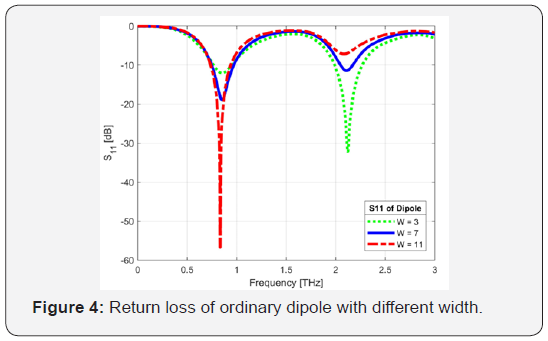
For W=11μm, directivity is obtained about 2.51dBi and radiation efficiency is achieved about 90%. These values are relatively constant for different width. In addition, bandwidth is obtained equal to 0.201THz. With shrinking ordinary dipole width, resonant frequency increase and antenna operates in second resonant frequency. This is clearly shown in Figure 4. For design of directive antenna, we can add a ground plate to bottom of substrate and be sure that the thickness of substrate is selected properly. This guarantees that the reflected waves from ground plate adds in-phase with the radiated waves.
Fractal dipoles
One of the nature inspired methods for bandwidth boosting, is fractal antennas design. Its features include low area, but unlimited circumference. Here we construct the proposed fractal dipole antenna by dividing each ordinary dipole antenna arm into three equal parts and creating a Koch curve with a 60° angle. The geometrical structure is depicted in Figure 3(b) while length of this antenna can be described by equation (3).

Where n is number of iterations and h states the initial length value. Regarding to the antenna width of 11μm and initial length value of 220μm, high numbers of repetitions cannot be achieved, and the shape of the antenna is achieved using single repetition.
By repeating on the ordinary dipole antenna, it was observed that the resonant frequency replaced, and this replacement was considerably tending to higher frequencies while has more bandwidth, and the resonant frequency for the fractalized ordinary dipole antenna was discussed, about 1.6terahertz was obtained and depicted in Figure 5.
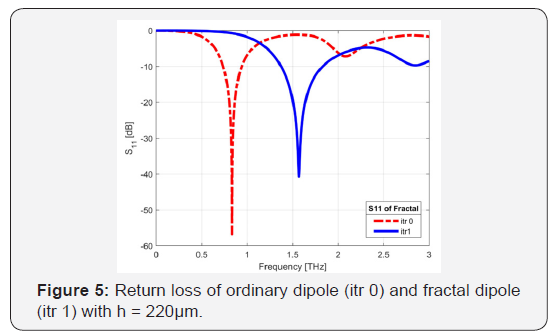
By increasing the length of the antenna, the resonant frequency can be reduced. Designed fractal antenna has 390μm length to resonate at the frequency of designed ordinary dipole. The fractal dipole shape for planar antenna creates sharp points and sharp points, which does not work well for distribution of the current on the antenna surface. To solve this problem, we can use the technique of rounding the sharp points, which results in rounding is the frequency shift, changes of matched impedance and radiation at higher frequencies.
Spirals
Spiral antennas with circular structure whose obvious characteristic are independent of frequency, due to their circular structure, usually have high bandwidth and circular polarization. The geometry of these antennas is shown in Figure 3(c). The important point in designing these antennas is attention to the relation D=λ /π, where D is the diameter of the large circle of the antenna and λ is the desired resonant wavelength.
The outer radius of antenna determines the lowest frequency of operation and usually approximated to occur when the wavelength is equal to the circumferences of largest circle in antenna [24]:

And the highest frequency in the round spiral antenna’s operating band occurs when the innermost radius of the spiral is equal to λ /4. The highest frequency can be determined from the inner radius [24]:

Designed antenna has D =145μm and the width of the graphene sheets is 11μm. The simulation results show that this structure exhibits good frequency independent behavior, which results is high bandwidth.
Bow-ties
Another frequency independent configuration which the basic feature of their structures is dependence on the bow and not the antenna’s length, is the bow-tie antenna. Easy design and broadband impedance are other features of this configuration. The structure of this terahertz graphene antenna is slightly different from its microwave model and its geometric shape is shown in Figure 3(d).
The results show that the increase in the angle θ leads to that the behavior independent of frequency of this configuration more apparent. Bow-tie structure is simulated with angles of 3, 15 and 45 degrees, W=11μm, L=225μm and the return loss is shown in Figure 6.
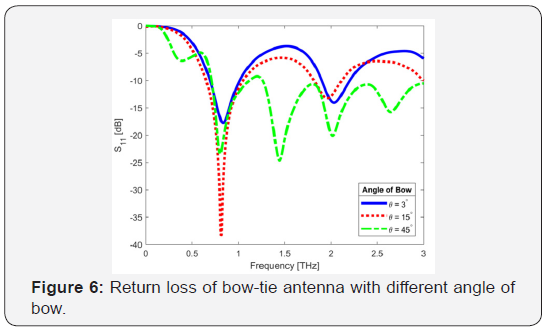
By circling the corners of the structure of this antenna, it can also improve the current distribution and thus achieve better radiation.
Log-periodics
The geometric structure of the log-periodic tooth planar antenna is shown in Figure 3(e). This structure is chosen in such a way that electrical properties are repeated with wavelength logarithms and the teeth of this antenna make it suitable for the distribution of current. If the values of β1 and β2 are chosen such that β1+β2=90˚, the antenna becomes self-complementary [25]. The ratio of the circles of the log-periodic tooth planar antenna is a constant number that gives the structure period:

In the designed antenna, the physical parameters appeared in Figure 3(e) are optimized as follows:
τ =1.96, Rn=169.3μm, β1=60˚, β2=30˚
The antenna radiates when the length of each arc An, is equal to λeff/2 which length of each arcs can be calculated as below:

Comparison
The return loss of the five antennas discussed is shown in Figure 7 and the designed frequency is 0.834THz. Spiral, bowtie and log-periodic antennas as expected, shown independent frequency behavior which can be seen well in Figure 7. The bandwidth of the ordinary dipole antenna is 0.2 terahertz. By changing the geometric structure of the antenna, the bandwidth has reached to 2.7terahertz, which corresponds to the logperiodic antenna.
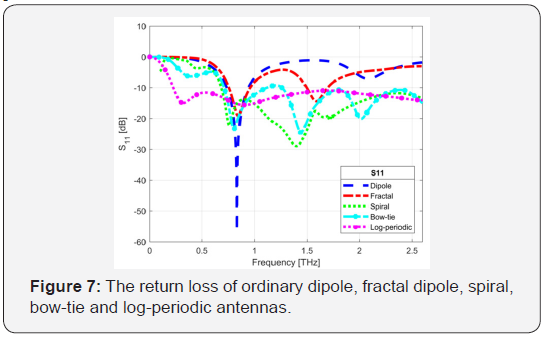
In order to study the performance of these terahertz graphene antenna, it is interesting to investigate the absorption cross section of these graphene patches with plane wave normal incident as shown in Figure 7. The meaning of high absorption is that the excitation of SPPs on the antenna surface is good and it does not necessarily, but it can radiate at these frequencies. The calculated absorption cross section of five configurations is depicted in Figure 8.
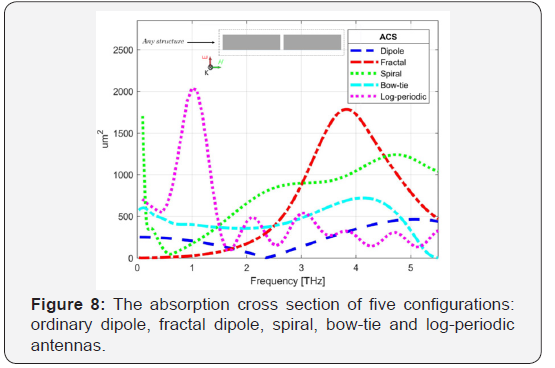
In lower frequencies of terahertz band, the absorption cross section of fractal dipole antenna is low, therefor the characteristics of the fractal dipole antenna at designed frequency compare to the ordinary dipole expected that it will not improve, but at higher frequencies, about 3.8THz, where the absorption cross section of fractalized dipole is much better than the ordinary dipole, the fractalized antenna features are expected to be improved. This analysis can also be done for the spiral antenna at designed frequency and expected that this structure has better parameters at higher frequencies. A remarkable point in comparing these configurations is the significant peak of absorption cross section in the log-periodic structure and the fractalized dipole antenna at the frequencies of about 1THz and 3.8THz respectively. This fact indicates the better excitation of the SPPs on the surface of these configurations.
The highest directivity between these five famous structures is 3.08dBi, which is related to the log-periodic antenna. As shown in Figure 9, all antennas except the spiral have null at angles of 0 and 180 degrees. The antennas discussed, do not have a narrow beam, so the concept of reconfigurable for these graphene antennas which can be obtained by applying the gate voltage, does not make sense. The polarization of the spiral antenna is also elliptic, while four other antennas have linear polarization.
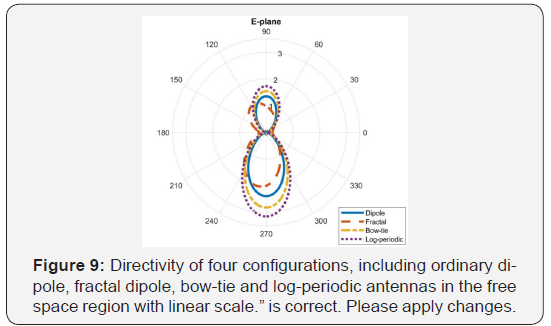
Regarding to comparison of board sizes, the log-periodic antenna occupies the largest size of the board which is approximately 6 times larger than ordinary dipole and after that is the bow-tie, fractalized dipole, spiral and ordinary dipole respectively.
According to results, the log-periodic antenna has better features in terms of directivity and bandwidth compared to the spiral antenna and less matched impedance, but in contrast, it has more occupied volumes. Comparison of these five configurations with consideration of important parameters is presented in Table 1.

Conclusion
Five different types of antenna were studied, analyzed and simulated. Ordinary dipole, fractalized dipole, spiral, bow-tie and log-periodic configurations are compared in terms of bandwidth, absorption cross section, directivity and finally board sizes. It was shown that by decreasing the width of the ordinary dipole antenna, the resonant frequency shifted towards higher frequencies and the antenna radiates at its second frequency resonance. It has been presented that fractalized ordinary dipole antenna has the frequency shift to higher frequencies and in lower frequencies of terahertz band, the SPPs cannot excite well in this configuration. It was observed that at lower frequencies of the terahertz band, as the bow angle increases from zero to 45 degrees, the behavior of independent of frequency becomes more apparent. The designed spiral and log-periodic antennas shown a good bandwidth and among these antennas, the log-periodic configuration has the best features in terms of bandwidth, absorption cross section and directivity. The calculated radiation efficiency for ordinary dipole, fractal dipole, spiral, bow-tie and log-periodic structures was 90%, 89%, 98%, 96% and 86% respectively.
References
- Geim AK., Konstantin S, Novoselov (2007) The rise of graphene. Nature materials 6(3): 183-191.
- Schwierz F (2010) Graphene transistors. Nature nanotechnology 5(7): 487-496.
- Wang X, Linjie Z, Klaus M (2008) Transparent, conductive graphene electrodes for dye-sensitized solar cells. Nano letters 8(1): 323-327.
- Vakil A, Engheta N (2011) Transformation optics using graphene, Science 332(6035): 1291–1294.
- Jablan M, Hrvoje B, Marin S (2009) Plasmonics in graphene at infrared frequencies. Physical review 80(24).
- Dawson, Ben D, et al. (2012) Measurement of plasmon dispersion in graphene: tunable graphene plasmonics. APS Meeting Abstracts.
- Jornet JM, Ian FA (2013) Graphene-based plasmonic nano-antenna for terahertz band communication in nanonetworks. IEEE Journal on selected areas in communications 31(12): 685-694.
- Novotny L (2007) Effective wavelength scaling for optical antennas. Physical Review Letters 98(26).
- Brewitt-Taylor CR, Gunton DJ, Rees HD (1981) Planar antennas on a dielectric surface. Electronics Letters 17(20): 729-731
- Llatser, Ignacio, Christian K, Dmitry N, Josep M, Max C, et al. (2012) Characterization of graphene-based nano-antennas in the terahertz band. Antennas and Propagation (EUCAP) 6th European Conference on IEEE.
- Costa KQ, Victor D, Clerisson M, Gustavo L (2014) Theoretical analysis of graphene nano antennas with different shapes. Microwave and Optical Technology Letters 56(5): 1019-1024.
- Dragoman M, et al. (2010) Terahertz antenna based on graphene. Journal of Applied Physics 107(10).
- Llatser I, ChristianK, Albert C, Josep M, Eduard A, et al. (2012) Graphene-based nano-patch antenna for terahertz radiation. Photonics and Nanostructures-Fundamentals and Applications 10(4): 353-358.
- Costa KQ, Dmitrievet V, Nascimento CM, Silvan GL (2013) Graphene nano antennas with different shapes. Microwave & Optoelectronics Conference (IMOC) SBMO/IEEE MTT-S International IEEE, Rio de Janeiro, Brazil.
- Falkovsky LA, Pershoguba SS (2007) Optical far-infrared properties of a graphene monolayer and multilayer. Physical Review 76(15): 153410.
- Hanson GW (2008) Dyadic Green’s functions for an anisotropic, nonlocal model of biased graphene. IEEE Transactions on Antennas and Propagation 56(3): 747-757.
- Dubinov AA, Aleshkin V Ya, V Mitin, T Otsuji, V Ryzhii (2011) Terahertz surface plasmons in optically pumped graphene structures. Journal of Physics: Condensed Matter 23(14).
- Long J, Baisong G, Jason H, Caglar G, Michael M, et al. (2011) Graphene plasmonics for tunable terahertz metamaterials.” Nature nanotechnology 6(10): 630-634.
- Koppens, Frank HL, Darrick EC, F. Javier García de (2011) Graphene plasmonics: a platform for strong light–matter interactions. Nano letters 11(8): 3370-3377.
- Mikhailov SA (2007) Non-linear electromagnetic response of graphene. EPL (Europhysics Letters) 79(2): 27002
- Al-Daffaie, Shihab, Oktay Y, Franko K, Hans H (2013) Graphene LTGGaAs photomixer for reliable continuous wave terahertz generation. Infrared, Millimeter, and Terahertz Waves (IRMMW-THz), 38th International Conference on. IEEE.
- Pliński E (2010) Terahertz photomixer. Bulletin of the Polish Academy of Sciences: Technical Sciences 58(4): 463-470.
- http://www.antenna-theory.com/antennas/broaddipole.php
- http://www.antenna-theory.com/antennas/travelling/spiral.php
- Rumsey VH (1966) Frequency independent antennas, Academic Press Inc. New York.






























